Santoku knives are Japanese knives primarily used for slicing, dicing, and chopping vegetables, fruits, and boneless meats. The word "santoku" means "three virtues" or "three uses," referring to the knife's ability to handle three types of cutting tasks: chopping, slicing and dicing.
Santoku knives can also be used for more delicate tasks such as mincing herbs or garlic, and some models even have a granton edge (small oval-shaped indentations on the blade) that helps prevent food from sticking to the blade.
Santoku knives are versatile and valuable tools in the kitchen, particularly for those who enjoy preparing Japanese or Asian-style cuisine.
The Santoku knife was created in response to changes in the Japanese diet, which was becoming increasingly influenced by Western cuisine. Unlike traditional Japanese knives designed for specific tasks, the Santoku knife was developed as a general-purpose kitchen knife that could perform a wide range of tasks. It was intended to be a more versatile alternative to the Japanese vegetable knife, known as the Nakiri, which is primarily used for chopping vegetables.
The design of the Santoku knife combined the features of a Western chef's knife, such as a wider blade and a curved cutting edge, with the traditional Japanese knife design.
The Santoku knife quickly became popular in Japan and began to gain popularity in other parts of the world in the 1980s and 1990s. Today, it is considered a staple in many home and professional kitchens around the world.
In recent years, various knife makers have adapted and modified the Santoku knife, resulting in a wide range of styles, sizes, and materials. However, the basic design principles of the Santoku knife remain true to its origins as a versatile and efficient kitchen tool.
What Santoku knife looks like?
A Santoku knife typically has a distinctive, wide blade with a straight cutting edge and a flat spine that curves down to meet the sharp, angled tip. The blade is typically shorter than a traditional Western chef's knife, usually around 5 to 8 inches long.
The blade of a Santoku knife is typically thinner and lighter than a Western chef's knife and is made of high-quality, hard steel. Some models may also feature a granton edge, a row of small, oval-shaped indentations along the blade that help prevent food from sticking to the blade while cutting.
The handle of a Santoku knife may be made of wood, plastic, or composite materials, and is typically designed to provide a comfortable grip and balance in the hand. Some models may also feature a full tang, where the blade extends through the handle, providing added strength and stability.
Buying a Santoku knife
When choosing a santoku knife, there are several factors to consider. First, look for a high-quality blade made from a durable material such as high-carbon stainless steel. The blade should be sharp and maintain its edge well.
You'll also want to consider the handle of the knife. Look for a comfortable grip that feels secure in your hand, as you'll use the knife for extended periods.
Finally, consider the size of the knife. Santoku knives typically come in sizes ranging from 5 to 7 inches, so choose a size that feels comfortable and well-balanced for your hand and the tasks you'll be using it for.
Overall, a well-made santoku knife can be a valuable addition to any kitchen, providing versatility and precision for various cooking tasks.
Get Free Bonus Books

Sign up for free to the Japanese Knife Club to get advice and exclusive articles about how to choose Japanese Knives, and tips and tricks for using Japanese knives.
About the author
Kei Nishida
Author, CEO Dream of Japan
Certification: PMP, BS in Computer Science
Education: Western Washington University
Kei Nishida is a passionate advocate of Japanese craftsmanship, a writer, and the founder and CEO of Japanese Knife Co., Japanese Green Tea Co., and Japanese Coffee Co., all part of Dream of Japan.
His journey began with a mission to introduce the world to the exquisite flavors of Japanese green tea. Through Japanese Green Tea Co., he pioneered the import of premium tea grown in nutrient-rich sugarcane soil, earning multiple Global Tea Champion awards. He then expanded into the world of coffee, launching Japanese Coffee Co., the first company to bring Sumiyaki charcoal-roasted coffee to a global audience.
With a deep appreciation for Japanese artistry and tradition, Kei turned his attention to one of Japan’s most revered crafts: bladesmithing. Through Japanese Knife Co., he made handcrafted katana-style knives, created by a renowned katana maker, available outside Japan for the first time. These exceptional knives embody centuries of samurai sword-making expertise, blending tradition with modern functionality for chefs and collectors alike.
Kei’s journey continues as he uncovers and shares Japan’s hidden treasures—one sip, one blade, and one legacy at a time.


























